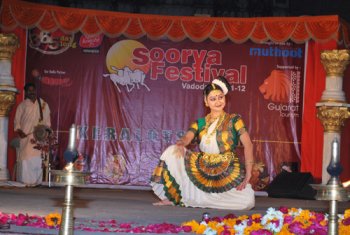
|   |

|   |
Urmila’s sensitive portrayal - Dr. SD Desai e-mail: sureshmrudula@yahoo.co.in March 14, 2012 Sita’s sister Urmila, the younger Maithili, is among the most silently suffering characters in world literature. Sita is a symbolic portrayal of an ideal wife of traditional Hindu perception. Urmila emerges as a round character, particularly in the light of the voice given to her sacrifice and anguish by post-Ramayan creative writers and performing artists.  One such noteworthy effort was made by Vadodara based Mohiniattam dancer Ayswaria Wariar at Soorya Festival, a small portion of which was brought to Ahmedabad by Darpana Academy last month. She gave an exhilarating solo performance on Urmila, visually interpreting Kavalam Narayana Panikkar’s sensitive padam, composed by him and movingly rendered vocally by Shiva Prasad. Suppressing her desire to accompany her husband Laxman, Urmila obeyed his express wish to remain home and look after the aged in-laws and spent fourteen long years of her youth in the huge royal palace. She feels empty of the warmth her beloved husband would have bestowed on her. For those who empathize with her, it is she who is in exile. Elegant in her dignity and noble by birth and of demeanor, she recalls initially in the performance that she is the king’s true auras putri and that Sita is hailed as a child ushering in chinmaya. This remains verbally the dhruva pankti all through and visually the recurring leitmotif. Transitory emotions come and go – the queen mother sharing with the king the joy of carrying a child, celebration of the birth, expression of vatsalya and so on besides in a separate episode, the king’s wonderment and affection and sense of divine significance on finding Sita as a girl child from the earth. Words soon enough turn to it, but Ayswaria’s gradually unfolding abhinaya takes time, which is pleasurable for the rasika, to start drawing towards Urmila’s sthayibhava of mental suffering. She, like others, is happy to see Rama getting triumphant at the swayamwar and later she is happier still to be his younger brother’s wife. She is unhappy at Rama’s exile and Sita following him. She is, however, jolted to see Laxman sloughing off royal costumes and ornaments and like a stoical ascetic, leaving Ayodhya and asking her not to accompany him. She faints. Art expresses its central theme through unspoken words. Ayswaria portrays Urmila’s solitary life, constantly thinking of Laxman and yet in vain trying to forget her suffering through pursuits of painting (she sees him in the image of the brilliant sun), music (she plays the veena) and literature (tries to read and write). This finally leads to the anchoring of her being from within. She realizes that she is contributing her mite as well to Laxman’s being the raksha kavach of the eternal Rama tattva. As the lines, repeated again and again, suggest that constantly thinking of Sita, Urmila herself attains a divine status, the dancer delectably develops the tempo, achieves the culmination of it and finally resolves into a state of ananda. For the rasika, however, there remains a tinge of personal pain to it. Dr. SD Desai, a professor of English, has been a Performing Arts critic for many years. Among dance journals, he has written for Attendance, Nartanam and Sruti. His books have been published by Gujarat Sahitya Academy and Oxford University Press. After 30 years with a national English daily, he is now a freelance writer. |